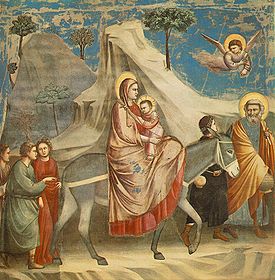- Matthew 2:14
-
 Giotto di Bondone's The Flight into Egypt
Giotto di Bondone's The Flight into Egypt
Matthew 2:14 is the fourteenth verse of the second chapter of the Gospel of Matthew in the New Testament. Joseph has been warned in a dream that he must flee to Egypt to escape the wrath of King Herod. An event known as the Flight into Egypt.
In the King James Version of the Bible the text reads:
- When he arose, he took the
- young child and his mother by
- night, and departed into Egypt:
The World English Bible translates the passage as:
- He arose and took the young
- child and his mother by night,
- and departed into Egypt,
For a collection of other versions see BibRef Matthew 2:14
As with Matthew 1:24 Joseph's obedience to his dream is immediate and unquestioning. Rapid obedience to God is an important virtue throughout the Gospel of Matthew. The family leaves at night, which was an unusual and dangerous time to travel in that era. This quick departure highlights Joseph's rapid obedience, and also the immediacy of the threat.[1] Matthew again is careful not to describe Joseph as the father of Jesus, only the husband of his mother.
That the Gospel of Luke does not mention this sojourn at all and rather has Jesus in the town of Nazareth within days of his birth.[2] This has inspired a number of attempts to reconcile the two gospels. At the time Egypt controlled Gaza, only a few miles from Bethlehem. Some evangelicals thus feel that the family merely made this brief, and unremarkable journey, and did not go to Egypt itself. However at the time Egypt generally referred to the Nile Valley and most readers would have interpreted the term much the same way modern readers would. If the author of Matthew was referring to Gaza he was creating something of a false impression. Bethlehem to the Nile Valley is about 150 miles, and the journey would have taken at least a week.[3]
The Flight into Egypt is a well known part of the Biblical story, and it is one very frequently depicted in works of art. However this brief verse is the only information the canon scriptures give to this voyage. Most of the traditions about this voyage come from the New Testament Apocrypha. These later works have a number of miraculous stories occurring on the voyage with palm trees bowing before the Infant Jesus and the beasts of the desert paying him homage. An encounter with the two thieves that would later be crucified alongside Jesus is also reported. In these tales the holy family are joined by Jesus' nurse Salome. The story of the palm trees makes it into the Qur'an with Sura 19:24 relating the event.
Why Matthew includes this trip to Egypt has also been debated by scholars. Stendhal's interpretation of Matthew 2 is that it is a lengthy apology for why the messiah left Bethlehem, a town of great religious importance, for the minor and little known Nazareth in Gentile Galilee. However, the side trip to Egypt does little to advance this argument. One view is that Matthew is presenting Jesus as Moses, but in reverse, to draw parallels with that other great Jewish leader. France feels that the trip to Egypt is part of Matthew greater interest in geography. France notes that in Matthew 4:24-25 the entire Holy Land is described as being aware of Jesus, while the arrival of the magi "from the east" in Matthew 2:1 is a reference to Mesopotamia. This leaves out only one major portion of the Jewish world: Egypt. France feels that this brief trip was added to cover this omission.[4]
References
- ^ France, R.T. "The Formula Quotations of Matthew 2 and the Problem of Communications." New Testament Studies. Vol. 27, 1981. pg. 79
- ^ Nolland, John. The Gospel of Matthew: a commentary on the Greek text. Wm. B. Eerdmans Publishing, 2005 pg. 109
- ^ France, R.T. "The Formula Quotations of Matthew 2 and the Problem of Communications." New Testament Studies. Vol. 27, 1981. pg. 79
- ^ France, R.T. "The Formula Quotations of Matthew 2 and the Problem of Communications." New Testament Studies. Vol. 27, 1981.
- Albright, W.F. and C.S. Mann. "Matthew." The Anchor Bible Series. New York: Doubleday & Company, 1971.
- Brown, Raymond E. The Birth of the Messiah: A Commentary on the Infancy Narratives in Matthew and Luke. London: G. Chapman, 1977.
Gospel of Matthew Preceded by:
Matthew 2:13Chapter 2 Followed by:
Matthew 2:15Categories:- Gospel of Matthew verses
Wikimedia Foundation. 2010.
